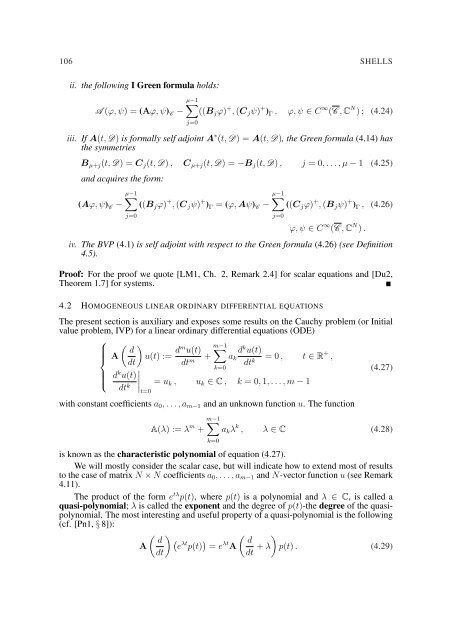EQUATIONS OF ELASTIC HYPERSURFACES
EQUATIONS OF ELASTIC HYPERSURFACES
EQUATIONS OF ELASTIC HYPERSURFACES
Create successful ePaper yourself
Turn your PDF publications into a flip-book with our unique Google optimized e-Paper software.
106 SHELLS<br />
ii. the following I Green formula holds:<br />
µ−1<br />
∑<br />
A (ϕ, ψ) = (Aϕ, ψ) C − ((B j ϕ) + , (C j ψ) + ) Γ , ϕ, ψ ∈ C ∞ (C , C N ) ; (4.24)<br />
j=0<br />
iii. If A(t, D) is formally self adjoint A ∗ (t, D) = A(t, D), the Green formula (4.14) has<br />
the symmetries<br />
B µ+j (t, D) = C j (t, D) , C µ+j (t, D) = −B j (t, D) , j = 0, . . . , µ − 1 (4.25)<br />
and acquires the form:<br />
µ−1<br />
µ−1<br />
∑<br />
∑<br />
(Aϕ, ψ) C − ((B j ϕ) + , (C j ψ) + ) Γ = (ϕ, Aψ) C − ((C j ϕ) + , (B j ψ) + ) Γ , (4.26)<br />
j=0<br />
j=0<br />
ϕ, ψ ∈ C ∞ (C , C N ) .<br />
iv. The BVP (4.1) is self adjoint with respect to the Green formula (4.26) (see Definition<br />
4.5).<br />
Proof: For the proof we quote [LM1, Ch. 2, Remark 2.4] for scalar equations and [Du2,<br />
Theorem 1.7] for systems.<br />
4.2 HOMOGENEOUS LINEAR ORDINARY DIFFERENTIAL <strong>EQUATIONS</strong><br />
The present section is auxiliary and exposes some results on the Cauchy problem (or Initial<br />
value problem, IVP) for a linear ordinary differential equations (ODE)<br />
⎧ ( d<br />
⎪⎨ A u(t) :=<br />
dt)<br />
dm m−1<br />
u(t)<br />
dt + ∑ d k u(t)<br />
a m<br />
k = 0 , t ∈ R + ,<br />
dt k<br />
⎪⎩<br />
k=0<br />
d k u(t)<br />
dt k ∣<br />
∣∣∣t=0<br />
= u k , u k ∈ C , k = 0, 1, . . . , m − 1<br />
with constant coefficients a 0 , . . . , a m−1 and an unknown function u. The function<br />
A(λ) := λ m +<br />
m−1<br />
∑<br />
k=0<br />
(4.27)<br />
a k λ k , λ ∈ C (4.28)<br />
is known as the characteristic polynomial of equation (4.27).<br />
We will mostly consider the scalar case, but will indicate how to extend most of results<br />
to the case of matrix N × N coefficients a 0 , . . . , a m−1 and N-vector function u (see Remark<br />
4.11).<br />
The product of the form e tλ p(t), where p(t) is a polynomial and λ ∈ C, is called a<br />
quasi-polynomial; λ is called the exponent and the degree of p(t)-the degree of the quasipolynomial.<br />
The most interesting and useful property of a quasi-polynomial is the following<br />
(cf. [Pn1, § 8]):<br />
( ) d (e<br />
A<br />
λt p(t) ) ( ) d<br />
= e λt A<br />
dt<br />
dt + λ p(t) . (4.29)

















